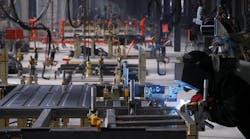Manufacturers should view emerging tech as relief from the workforce crunch
The key to closing the talent gap may lie in the strategic utilization of emerging technologies.
For an industry with such robust job growth, the challenges facing manufacturing appear surprising at first glance. U.S. manufacturing added 23,000 jobs in January 2024 alone.
Add to that number the 601,000 open U.S. positions in industry as of December 2023—a three-month high, according to Bureau of Labor Statistics data.
Despite all this job creation, the shortage of skilled workers keeps most of these positions vacant, a significant problem that manufacturers in every vertical across America are feeling and working on addressing.
It’s going to only get worse: The National Association of Manufacturers reports that 2.1 million U.S. manufacturing jobs could go unfilled by 2030.
See also: Future-proofing your operations: Automation support through the looming labor crisis
At the same time, emerging technologies like artificial intelligence (AI) and the internet of Things (IoT) have grown their presence on factory floors. Manufacturers are experimenting with ways to make their operations smarter and more connected, resulting in a shift in the job expectations for people populating the manufacturing workforce.
Jobs that were once hands-on are becoming more technical, with workers overseeing software and complex robotics in addition to machinery. Traditional trade skills are still in demand, but the need for technical expertise is growing, too—and the most valuable workers tend to understand both aspects of the job.
Ongoing transfer of knowledge in a transitioning labor force
The transfer of knowledge in a transitioning workforce is both enhanced and challenged by technological innovation. For example, new technology can help us do things like capture and transfer knowledge much better than in the past, but it can also hinder things like getting hands-on experience through trial and error because of the availability of more digital tools.
The manufacturing organizations that will come out on top will be able to successfully embrace the collaborative workforce cultures of the past, while deploying emerging technologies that create an integrated, interconnected ecosystem of diverse workers and technology in a workplace that spans digital, physical, and virtual environments. Digitization can help achieve workforce balance by creating more common ground between legacy workers, new recruits, and management.
Upskilling and cross-skilling with digitization
We see that manufacturers often struggle to find ways to effectively capture and reuse legacy knowledge. A legacy workforce can be a treasured asset because of the years of hands-on experience and knowledge built over time.
Knowing how to fix a broken part, where a specifically shaped piece fits or how to operate a specialized piece of equipment is not learned in a day, and as a growing number of legacy workers near retirement (in 2022, nearly one-third of the manufacturing workforce was over 55 years of age) it will be important that that knowledge base is not lost.
Podcast: Helping military veterans transition to manufacturing
One way to preserve this knowledge is to lean into the flexibility that digitization offers through the creation of the “industrial metaverse”—a collection of technologies that, together, create synergies between virtually any location with a broadband internet connection—drastically increasing opportunities for manufacturers to enhance their business both within and beyond the production environment of a factory.
Manufacturers are looking to this industrial metaverse to offer new, efficient, enhanced, and flexible training methods that can be accessed even from remote locations. Gen-AI and augmented reality are a big part of this.
Imagine a virtual training session between an employee with 20 years of experience in Wichita, Kansas, and new recruits in Boston, Detroit, and Houston. Their physical realities are each overlayed with a digital component, and they’re experimenting with different solutions by running various simulations through Gen-AI tools.
Podcast: Women exploring careers in manufacturing
They’re maintaining a culture of collaboration even if they’re not together, and they’re discovering new strategies that humans without technology could never achieve. Recruits AND experienced employees learn from each other, creating a two-way upskilling process that delivers increased mobility options for both generations.
Deloitte’s 2024 Manufacturing Outlook outlines a number of ways in which manufacturers have made investments in technology that result in increased collaboration and efficiency. Additional strategies should be considered in 2024 to continue building on this momentum.
AI as a tool to seek out highly skilled workers
Manufacturers also face challenges in acquiring the right talent to meet existing and future demand. To quantify the need for employees in both new and established manufacturing facilities, companies are introducing the use of digital tools such as AI.
By taking a distributed talent approach to workforce optimization, organizations can tap into a much broader talent pool to sense the local labor market and generate approaches for marketing jobs to potential employees. Even if their experience isn’t in manufacturing, AI can look for skills that translate well into most if not all verticals in industry.
See also: Manufacturers kick 2024 into action with tech, people-focused approach
Some organizations that use innovative tools, like mobile applications that leverage AI to engage and perform basic screening of potential employees, have been able to increase their pool of difficult-to-find, higher-skilled workers. By investing in the tech that can expand their workforce, manufacturers can invest in their future.
Making manufacturing jobs more attractive to young talent
Adopting emerging technology on factory floors can make manufacturing roles more attractive to young talent, leading to a workforce that is empowered to focus on value-driven work as part of a multifaceted group that is all working toward mission outcomes.
Young talent—especially Gen Z—expects their places of employment to deploy the latest emerging tech. They are digital natives, and manufacturers must provide them with the tools they want to use if they want to get them in the door. This shows that “smart” manufacturing technology isn’t just a value add for operational efficiency—it’s a powerful recruiting tool that can move the needle on high-quality talent and the continued innovation that comes along with it.
Podcast: The month in manufacturing—data difficulties, technology trends, and much more
It’s important that the manufacturing workforce be thought of as an ecosystem of humans and technologies across the physical and digital worlds, all working together to get today's jobs done while preparing for tomorrow’s challenges.
As capabilities in AI, machine learning, and robotics are evolving fast, they are driving opportunities to redesign work entirely. Manufacturing organizations need to get this right to protect against the loss of legacy knowledge and intrigue the next generation to want to do this work.
By keeping the human worker at the center of workforce decisions, organizations can focus on collaboration and integration across their ecosystem. Digital tools have a lot to offer manufacturing organizations that are ready to take the next step toward securing their future workforce.




